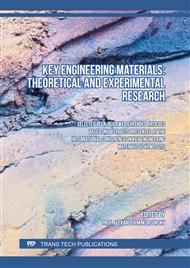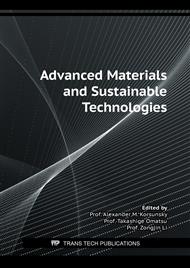[1]
R. Wen, S. Xu, X. Ma, Y.C. Lee, R. Yang, Three-Dimensional Superhydrophobic Nanowire Networks for Enhancing Condensation Heat Transfer, Joule 2 (2018) 269–279.
DOI: 10.1016/j.joule.2017.11.010
Google Scholar
[2]
C.J. Ting, M.C. Huang, H.Y. Tsai, C.P. Chou, C.C. Fu, Low cost fabrication of the large-area anti-reflection films from polymer by nanoimprint/hot-embossing technology, Nanotech. 19 (2008) 205301-205306.
DOI: 10.1088/0957-4484/19/20/205301
Google Scholar
[3]
W. Yu, M. Wang, H. Xie, Y. Hu, L. Chen, Silicon carbide nanowires suspensions with high thermal transport properties, Appl Therm Eng 94 (2016) 350–354.
DOI: 10.1016/j.applthermaleng.2015.10.116
Google Scholar
[4]
X. Chen, C.K.Y. Wong, C.A. Yuan, G. Zhang, Nanowire-based gas sensors, Sensors Actuators, B Chem 177 (2013) 178–195.
DOI: 10.1016/j.snb.2012.10.134
Google Scholar
[5]
N.J. Trujillo, S.H. Baxamusa, K.K. Gleason, Multi-scale grafted polymeric nanostructures patterned bottom-up by colloidal lithography and initiated Chemical Vapor Deposition (iCVD), Mater Res Soc Symp Proc 1134 (2008) 235–242.
DOI: 10.1557/proc-1134-bb08-27
Google Scholar
[6]
W. Dong, K. Zhang, Y. Zhang, T. Wei, Y. Sun, X. Chen & N. Dai, Application of three-dimensionally area-selective atomic layer deposition for selectively coating the vertical surfaces of standing nanopillars. Sci Rep 4 (2014) 3–6.
DOI: 10.1038/srep04458
Google Scholar
[7]
W. Zhou, H. Qian, L. Wang, Maskless Fabrication of Highly-Ordered Periodic Nanopillars using FIB and Bitmap Control, Microsc Microanal 11 (2005) 10–12.
DOI: 10.1017/s1431927605508924
Google Scholar
[8]
Y. Li, Y. Hao, C. Huang, X. Chen, X. Chen, Y. Cui, C. Yuan, K. Qiu, H. Ge, Y. Chen, Wafer Scale Fabrication of Dense and High Aspect Ratio Sub-50 nm Nanopillars from Phase Separation of Cross-Linkable Polysiloxane/Polystyrene Blend, ACS Appl Mater Interfaces 9 (2017) 13685–13693.
DOI: 10.1021/acsami.7b00106
Google Scholar
[9]
M.K. Choi, H. Yoon, K. Lee, K. Shin, Simple fabrication of asymmetric high-aspect-ratio polymer nanopillars by reusable AAO templates, Langmuir 27 (2011) 2132–2137.
DOI: 10.1021/la104839a
Google Scholar
[10]
W. Kim, S. Hwang, T.Y. Kim, W.G. Ham, S. Kim, M. Lee, C.K. Hwangbo, Department. Facile Fabrication Method for Broadband Al Wire Grid Polarizers Using Nanoimprint Lithography and Oblique Angle Deposition, Sci Adv Mater 10 (2018) 660–664.
DOI: 10.1166/sam.2018.3142
Google Scholar
[11]
J.J. Heikkinen, E. Peltola, N. Wester, S.Franssila, V. Jokinen, J. Koskinen, T. Laurila, Fabrication of micro- and nanopillars from pyrolytic carbon and tetrahedral amorphous carbon. Micromachines 10 (2019) 5–8.
DOI: 10.3390/mi10080510
Google Scholar
[12]
L. Zaraska, G.D. Sulka, M. Jaskuła, Anodic alumina membranes with defined pore diameters and thicknesses obtained by adjusting the anodizing duration and pore opening/widening time, J Solid State Electrochem 15 (2011) 2427–2436.
DOI: 10.1007/s10008-011-1471-z
Google Scholar
[13]
Q. Zhang, M. Wu, W. Zhao, Electroless nickel plating on hollow glass microspheres, Surf Coatings Technol 192 (2005) 213–219.
DOI: 10.1016/j.surfcoat.2004.06.013
Google Scholar
[14]
J. Jadto, S. Porntheeraphat, S. Pratontep, A. Eiad-ua1, Effect of anodization process on morphology of nickel coating materials, Advanced Materials Research 802 (2013) 114-118.
DOI: 10.4028/www.scientific.net/amr.802.114
Google Scholar
[15]
Y.J. Peng, H.X. Huang, H. Xie, Rapid fabrication of antireflective pyramid structure on polystyrene film used as protective layer of solar cell, Sol Energy Mater Sol Cells 171 (2017) 98–105.
DOI: 10.1016/j.solmat.2017.06.013
Google Scholar
[16]
S.H. Lee, K.S. Han, J.H. Shin, S.Y. Hwang, H. Lee, Fabrication of highly transparent self‐cleaning protection films for photovoltaic systems, Progress in Photovoltaics: Research & Applications 21 (2012) 1056–1062.
DOI: 10.1002/pip.2203
Google Scholar
[17]
W. Shao, P. Lu, W. Li, J. Xu, L. Xu, K. Chen, Simulation and Experimental Study on Anti-reflection Characteristics of Nano-patterned Si Structures for Si Quantum Dot-Based Light-Emitting Devices, Nanoscale Res Lett 11 (2016) 1-7.
DOI: 10.1186/s11671-016-1530-6
Google Scholar
[18]
D. Patil, A. Sharma, S. Aravindan, P.V. Rao, Development of hot embossing setup and fabrication of ordered nanostructures on large area of polymer surface for antibiofouling application, Micro Nano Lett 14 (2019) 191–195.
DOI: 10.1049/mnl.2018.5462
Google Scholar



